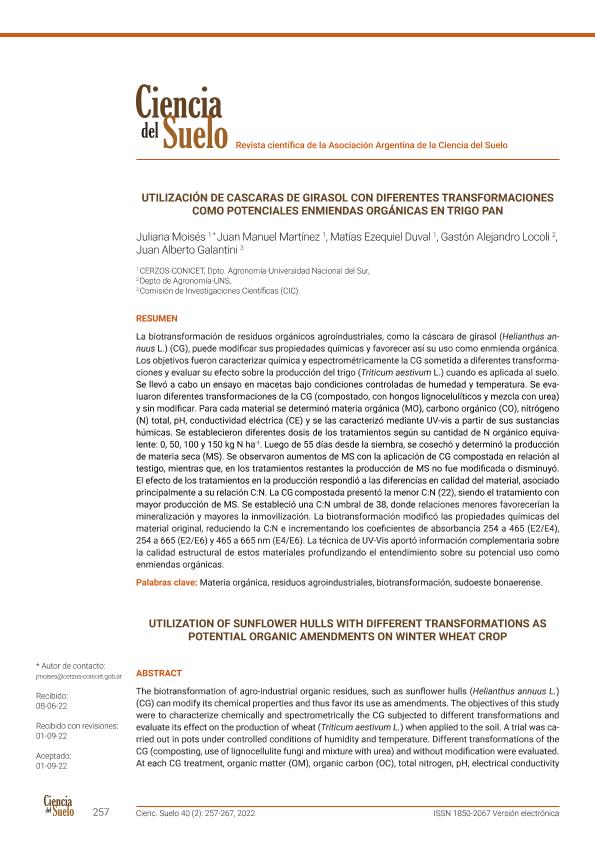Artículo
La biotransformación de residuos orgánicos agroindustriales, como la cáscara de girasol (Helianthus annuus L.) (CG), puede modificar sus propiedades químicas y favorecer así su uso como enmienda orgánica. Los objetivos fueron caracterizar química y espectrométricamente la CG sometida a diferentes transformaciones y evaluar su efecto sobre la producción del trigo (Triticum aestivum L.) cuando es aplicada al suelo. Se llevó a cabo un ensayo en macetas bajo condiciones controladas de humedad y temperatura. Se evaluaron diferentes transformaciones de la CG (compostado, con hongos lignocelulíticos y mezcla con urea) y sin modificar. Para cada material se determinó materia orgánica (MO), carbono orgánico (CO), nitrógeno (N) total, pH, conductividad eléctrica (CE) y se las caracterizó mediante UV-vis a partir de sus sustancias húmicas. Se establecieron diferentes dosis de los tratamientos según su cantidad de N orgánico equivalente: 0, 50, 100 y 150 kg N ha-1. Luego de 55 días desde la siembra, se cosechó y determinó la producción de materia seca (MS). Se observaron aumentos de MS con la aplicación de CG compostada en relación al testigo, mientras que, en los tratamientos restantes la producción de MS no fue modificada o disminuyó. El efecto de los tratamientos en la producción respondió a las diferencias en calidad del material, asociado principalmente a su relación C:N. La CG compostada presentó la menor C:N (22), siendo el tratamiento con mayor producción de MS. Se estableció una C:N umbral de 38, donde relaciones menores favorecerían la mineralización y mayores la inmovilización. La biotransformación modificó las propiedades químicas del material original, reduciendo la C:N e incrementando los coeficientes de absorbancia 254 a 465 (E2/E4), 254 a 665 (E2/E6) y 465 a 665 nm (E4/E6). La técnica de UV-Vis aportó información complementaria sobre la calidad estructural de estos materiales profundizando el entendimiento sobre su potencial uso como enmiendas orgánicas. The biotransformation of agro-industrial organic residues, such as sunflower hulls (Helianthus annuus L.) (CG) can modify its chemical properties and thus favor its use as amendments. The objectives of this study were to characterize chemically and spectrometrically the CG subjected to different transformations and evaluate its effect on the production of wheat (Triticum aestivum L.) when applied to the soil. A trial was carried out in pots under controlled conditions of humidity and temperature. Different transformations of the CG (composting, use of lignocellulite fungi and mixture with urea) and without modification were evaluated. At each CG treatment, organic matter (OM), organic carbon (OC), total nitrogen, pH, electrical conductivity (EC) were determined and they were characterized by UV-vis from their humic substances. Different level inputs of the treatments were established according to their amount of equivalent organic nitrogen (N): 0, 50, 100 and 150 kg N ha-1 . After 55 days of sowing, wheat was harvested and the dry matter (DM) production was determined. Increases in the DM production of wheat were observed with the application of composted CG in relation to the control, while in the remaining treatments the DM production was not modified or decreased. The effect on DM production was clearly related to the materials quality differences, mainly associated with its C:N ratio. The composted CG presented the lowest C:N (22), being the treatment with the highest wheat DM production. A threshold C:N of 38 was established, where lower ratios favor mineralization and higher immobilization. The biotransformation modified the chemical properties of the original material, reducing the C:N and increasing the absorbance coefficients 254 to 465 (E2/E4), 254 to 665 (E2/ E6) and 465 to 665 nm (E4/E6). The UV-Vis technique provided complementary information for the structural quality of these materials deepening the understanding about its potential use organic amendments.
Utilización de cascara de girasol con diferentes transformaciones como potenciales enmiendas orgánicas en trigo pan
Título:
Utilization of sunflower hulls with different transformations as potential organic amendments on winter wheat crop
Moisés, Juliana ; Martinez, Juan Manuel
; Martinez, Juan Manuel ; Duval, Matias Ezequiel
; Duval, Matias Ezequiel ; Iocoli, Gastón Alejandro
; Iocoli, Gastón Alejandro ; Galantini, Juan Alberto
; Galantini, Juan Alberto
 ; Martinez, Juan Manuel
; Martinez, Juan Manuel ; Duval, Matias Ezequiel
; Duval, Matias Ezequiel ; Iocoli, Gastón Alejandro
; Iocoli, Gastón Alejandro ; Galantini, Juan Alberto
; Galantini, Juan Alberto
Fecha de publicación:
29/12/2022
Editorial:
Asociación Argentina de la Ciencia del Suelo
Revista:
Ciencia del Suelo
ISSN:
0326-3169
Idioma:
Español
Tipo de recurso:
Artículo publicado
Clasificación temática:
Resumen
Archivos asociados
Licencia
Identificadores
Colecciones
Articulos(CERZOS)
Articulos de CENTRO REC.NAT.RENOVABLES DE ZONA SEMIARIDA(I)
Articulos de CENTRO REC.NAT.RENOVABLES DE ZONA SEMIARIDA(I)
Citación
Moisés, Juliana; Martinez, Juan Manuel; Duval, Matias Ezequiel; Iocoli, Gastón Alejandro; Galantini, Juan Alberto; Utilización de cascara de girasol con diferentes transformaciones como potenciales enmiendas orgánicas en trigo pan; Asociación Argentina de la Ciencia del Suelo; Ciencia del Suelo; 40; 2; 29-12-2022; 257-267
Compartir



